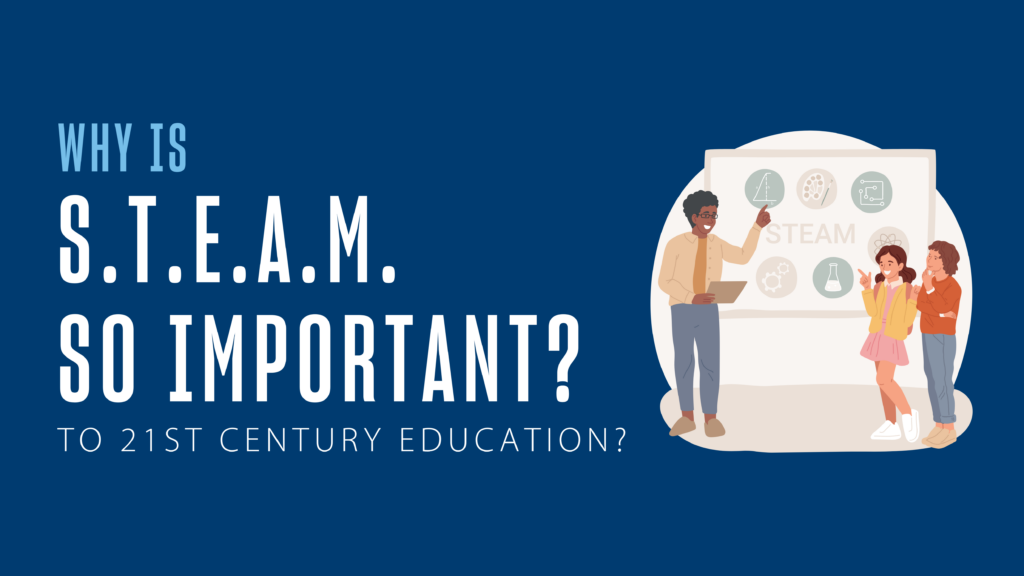In recent years, there has been a push to emphasize STEAM subjects, (Science, Technology, Engineering, Art and Math) in K-12 schools. The push has been prompted by several factors, including the belief that our country’s position in the world largely depends upon innovation in these key areas. It has been noted that economically dominant countries tend to have populations with strong STEAM skills — there is a lot of money to be made in these fields and many jobs to be created.
Download our free eBook to learn the top reasons to get your Master of Education degree >>
Beyond maintaining our place on the world stage, the teaching of STEAM subjects can improve students’ analytical ability and offer them the tools they need to deal with and extract valuable insights from large, complex data sets — a critical skill in today’s data rich world. While there is little question as to the importance of teaching STEAM in schools, the “A” in STEAM is a more recent addition and is still controversial among some who believe that adding art to STEM waters down the critical subjects of math, science, engineering and tech.
Why the ‘A’ Matters
Not so, says Joi Spencer, PhD, mathematics learning theorist and associate dean at the University of San Diego. “I think that perhaps what they [critics of adding art to STEM] might miss is that we lose a lot of students in mathematics and science very early on because they are convinced they are not the kind of kids that can do math or science. We are losing a lot of wonderfully talented young people because they get out of the game before they really get off the ground. It is our approach, our attitude of conceiving of only one kind of student being able to be good in math or science. We must open up our vision of what it means to be good at this type of work. Other countries are outpacing us because they are willing to embrace a lot of young people in this work, while we dismiss so many of them.”
“Education has to become a lot more inclusive of how young people see and make sense of the world,” remarked Dr. Spencer. “Traditionally school has been very technical. Kids that can spell perfectly and do calculations are confirmed by our school systems. And there is nothing wrong with that, but it leaves out a lot of other wonderful ways of thinking and engaging in the world — very valuable ways of learning that we often discount in school. By doing that we tell kids that their contributions don’t matter, that they aren’t smart, and we miss out on some of the great things that could come out of education. What if schools were more open to different ways of being? This is why the arts are important — the arts open a window to new ways of thinking.”
Those in favor of adding the “A” to STEM believe that the arts bring a process of thinking to the STEM subjects that is critical for learning and innovation. “We tend to oversimplify,” said Dr. Spencer. “It isn’t just about adding drawing or dance into a science class, it is about a different type of thinking process. The design thinking and process that an engineer employs, for example, when developing a product is quite similar to the process an artist uses – design a prototype, build, test, fix, repeat.”
Similarly, music, a discipline in the arts, is created through employing mathematical thinking to create time and measure. Ballet, another art form, relies upon count, symmetry and angles. Using the arts to teach the other STEM subjects can create an avenue for students who may otherwise be bored or have a hard time grasping abstract math or science facts. Not only that, but teaching STEM subjects through real-life examples helps to illustrate the importance of STEM subjects across every discipline and part of life.
In today’s schools, the arts often suffer from a lack of funding, attention and priority. As a result, many students believe they don’t have artistic skills or creative talent. Involving them in the arts through prioritizing STEAM can open a window into a world they never thought they belonged to and forces them to stretch their minds to new ways of thinking and new possibilities. “That’s what true learning is,” said Dr. Spencer.
For the students who already see through an artistic lens or don’t fit into the traditional educational model, adding the “A” to STEM helps these kids to see that their way of thinking is in fact connected to the world. For example, the iPhone would not have been possible without a designer; in fact much of Apple’s success is due in part to the minimalistic and sleek design of their products. When a student sees that design and technology are intricately linked it can be very powerful.
Bringing STEAM to the Classroom
According to Dr. Spencer, the true power of STEAM lies in its ability to push kids and teachers alike to think harder; to think differently; and to think courageously. “In the same way students can be uninspired by school, teachers can be uninspired by their work,” said Dr. Spencer. “When school is prescriptive, saying this is the way it is and always has been, that is uninspiring. If I am just asking you to fill in a bubble or tell me the square root of a number, that is just repeating, it’s not learning. Teachers need to be reinvigorated in the work of teaching.” The arts are an avenue for not only reinvigorating students, but reinvigorating teachers.
As Dr. Spencer explained, STEAM thinking is about pushing both students and teachers to think harder, to ask important questions, to evaluate and analyze, because those are all the components of rich learning. And rich learning is contagious. When teachers start asking better questions, it is not only inspiring, it is transformative.
The arts hold the promise to teach students a new process of thinking, letting them conceive of their own learning as a design process through which questions are asked, prototypes are built, analysis occurs, feedback is requested and improvements are made. But just as students are being encouraged to rethink how they learn, teachers can follow the same principles to transform their teaching. “Teaching is a design process,” said Dr. Spencer. “Teachers create a lesson plan (prototype), test it, critique it and adjust it as needed.” It is an ongoing process, learning. And helping students learn is about getting to know each student and how each student will learn best. It is designing, through tests and analysis, the best approach for each learner.
Currently, in most classrooms, students are given a writing assignment, for example, and that assignment is written, handed in, graded and then never thought about again. But what if everything was part of a process? This is what the A in STEAM encourages. In a process-driven approach, a student might be given a writing assignment, which they write and then open up to the class for critique. Then the student returns to the assignment and reworks it based off of the criticism he/she received. In many ways, this process-driven approach actually mimics what happens in real life. If we are to prepare our students with applicable, real-world skills, it is important that we teach them how to implement a design, process-driven approach to learning — one that mimics the creative process by questioning, implementing, assessing, and revising.
While STEAM is still gaining ground, certain innovative teachers and schools have started to implement STEAM-driven projects.
One Master of Education graduate from the University of San Diego started an afterschool STEAM program where kids developed their own mini airplanes. Their assignment, once the airplane was complete, was to get the plane from one side of the room to the other with just one push. There could be no other force. Working in groups, the students had to consider several factors including the weight of the materials, the slope of their glide path, etc.
“As a learning theorist, listening to the students engage in these conversations is very exciting,” remarked Dr. Spencer.
In another classroom, students were asked to build mini solar houses which required powerful thinking across all the STEAM subjects. The students’ solar houses had to be designed in such a way that they stayed warm in the winter and cool in the summer.
“There is something extremely special about that moment when you see the light in your student’s eye go on — when you know learning has happened. One of the basic principles of learning is that learning is its own reward,” said Dr. Spencer. “The arts can give students a greater opportunity to engage in deep learning and to be excited about their own learning and growth — and that is the reward they get, that we get as a society.”
In addition to her work as a learning theorist, Dr. Joi Spencer teaches at The University of San Diego, in their 100% online Master of Education degree program. The MEd program at USD also offers a specialization in STEAM, for educators who are looking to take their teaching to the next level and implement new ways of thinking and learning in the classroom. Contact us to learn more.





